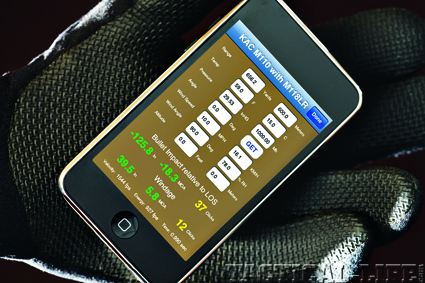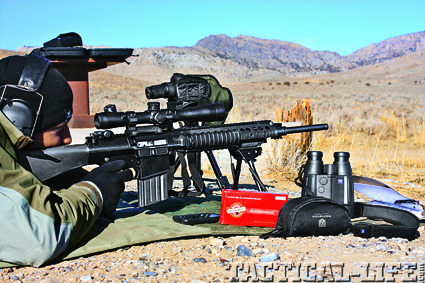The semi-automatic action allows operators to engage multiple targets. Its similarity in appearance to a standard M-16 diminishes the likelihood of an enemy’s observation of a sniper’s presence during insertions with friendly patrols.
The SR-25 is the weapon platform that ushered in, or was rather a product of, a paradigm shift in the U.S. military’s thinking on sniper weapons. KAC’s (Knight’s Armament Company) SR-25 system has come to the battlefield and provides U.S. Special Operations Forces an accurate, semi-automatic platform with bolt-gun accuracy on multiple targets out to 800 meters, and eliminates the need for snipers to carry a defensive second rifle. Built into the familiar Stoner/AR design, the SR-25 can deliver five shots in five seconds and carries a 20-round magazine, thus surpassing the bolt-action rifle in both rate and duration of fire.
As noted by Maj. John Plaster, former Special Forces officer and the author of The Ultimate Sniper, “One of the key strengths of the SR-25 system, in addition to the rate of fire, is that a sniper does not have to change his body position or stock weld between shots. The sniper can adjust his point of aim or adjust to secondary targets through his scope without the need to lift off the weapon and cycle the bolt.” Additionally, the SR-25’s similarity in appearance to a standard AR-platform rifle is far less conspicuous than a long gun when exiting friendly lines, thus giving enemy observers less warning that a sniper is operating in the area.
Advertisement — Continue Reading Below
 BulletFlight calculates and delivers accurate shot solution data to the handheld phone or PDA of both the seasoned operator and conventional small unit
BulletFlight calculates and delivers accurate shot solution data to the handheld phone or PDA of both the seasoned operator and conventional small unit
soldier.
Chambered for the 7.62x51mm (.308) round, the SR-25’s design is both an extension of existing weapons development and a radical step forward. To support and extend the rifle’s battlefield sustainability, 60% of the parts are interchangeable with the AR-15/M16 system. Significant changes begin with the free-floating, match grade barrel that is now delivered in a 20-inch Obermeyer steel alloy and 16-inch chrome plated versions capable of sustained .5 MOA accuracy. The rotating bolt and direct-impingement gas system is based on Eugene Stoner’s designs and evolved further by C. Reed Knight, Jr. In order to both protect the free-floating barrel and accommodate sighting and rail mounted devices, KAC developed the Rail Adapter System II Upper Receiver Extension (RASIIURX). While slight variations exist between the Army, Navy and Marine Corp packages, the SR-25 system is typically outfitted with the 3.5-10x40mm Leupold Mk IV mil-dot scope, Harris bipod and KAC QD suppressor. Variants delivered to U.S. forces include more than 3,000 of the U.S. Army’s M110 SASS (Semi-Automatic Sniper System) and the 3,500 of U.S. Navy’s and Marine Corp’s Mk 11 Mod 0, 1&2. These deliveries are not only for use in the scout/sniper ranks, but are also finding themselves in the grateful hands of an increasing number of Designated Marksmen. Other branches of the U.S. government including the Department of State and Department of Energy have also adopted versions for their respective missions. Both in the hands of the trained sniper and the Designated Marksman, the SR-25 variants have seen direct action with Allied forces for more than six years. David Jones, a retired SEAL sniper who carried the Mk11 Mod 0 throughout two tours in Afghanistan, consistently had 1MOA accuracy out to 1,100 yards.























